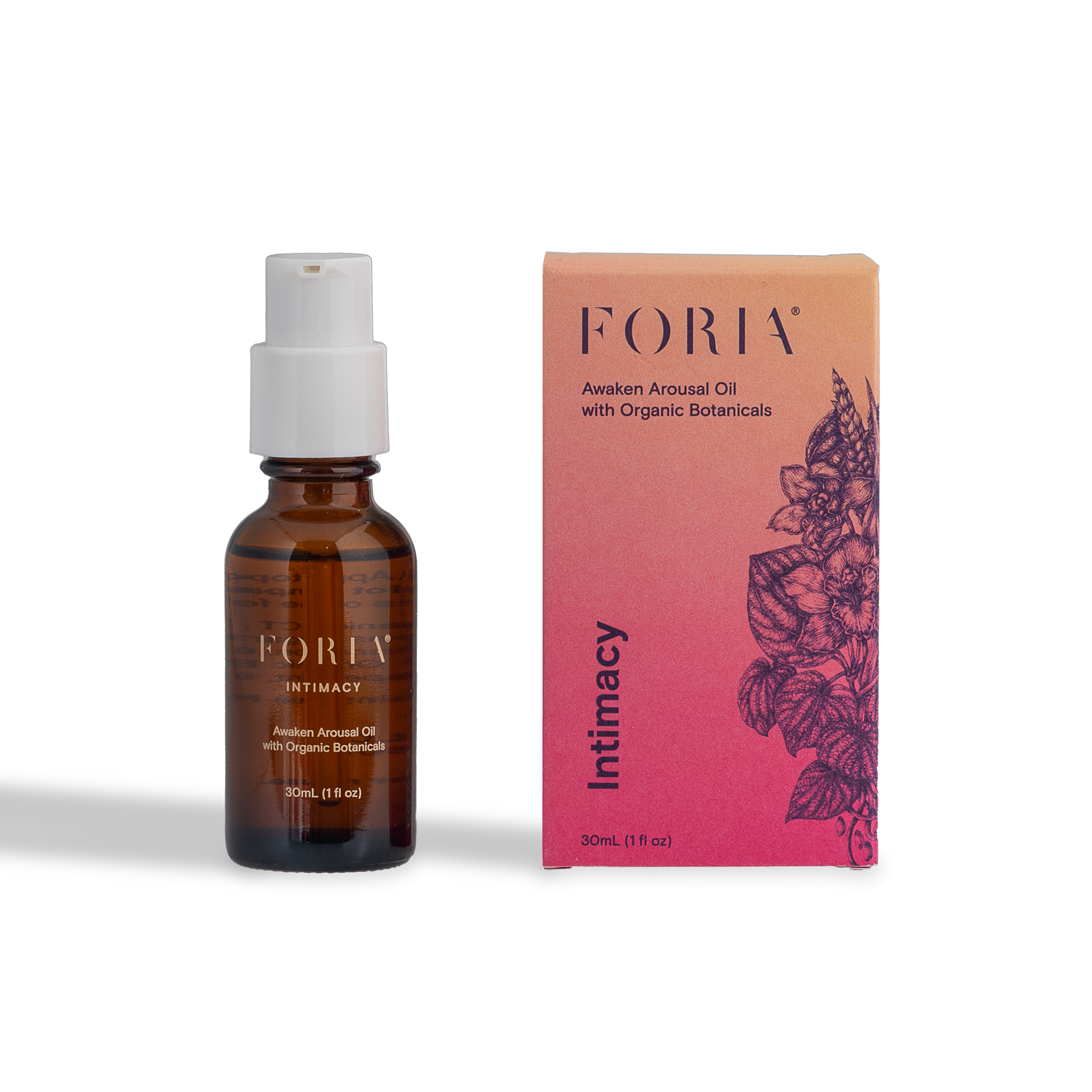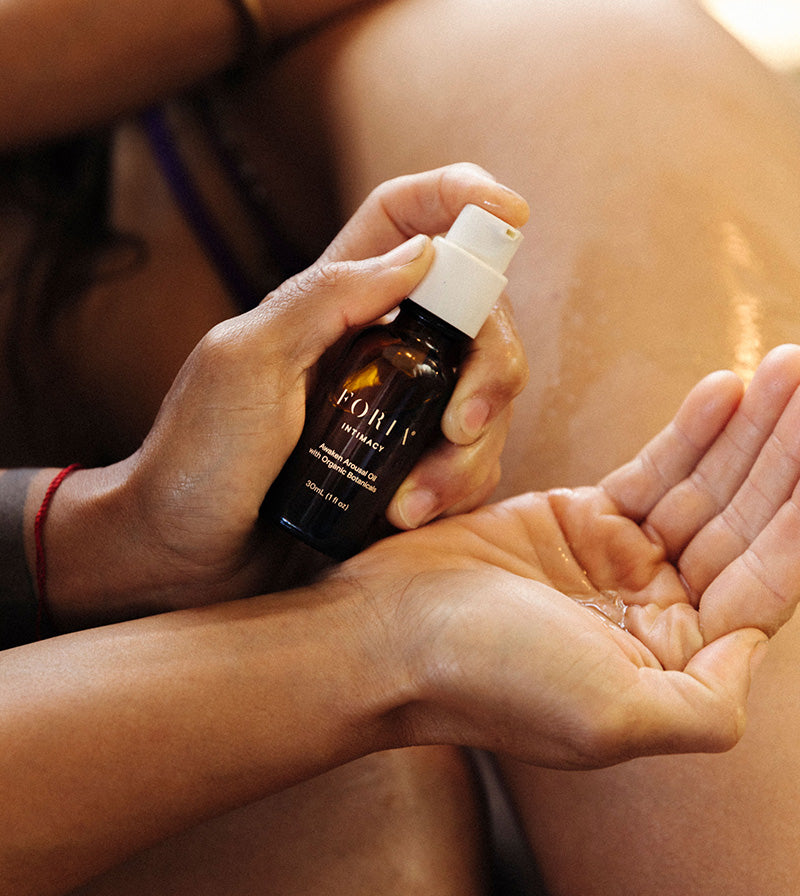Female pleasure runs deep. It’s varied, complex and as individual as a fingerprint, and understanding your unique anatomy is key to unlocking your pleasure for life.
And you might think you know what turns you on and gets you off – but once you learn what’s really under the hood, get ready for turbocharged orgasm power.
Sneak preview: Did you know that G-spot orgasms are partly clitoral orgasms? Yep, the clitoris is huge – and you won’t believe how long it took modern science to figure that one out.
To this day, people who identify as women report experiencing much less pleasure with partnered sex than their male partners. That phenomenon is known as the “pleasure gap”, and closing that gap is one of the main reasons why Foria exists.
If you’re unsatisfied with the quality and quantity of your orgasms, know that there’s nothing wrong with you. We designed our Sex & Intimacy Collection to support female pleasure in all its marvelous forms, and encourage you to discover your unique capacity for deep and satisfying sexual intimacy.
A recent study showed that people with more “clitoral knowledge” have better orgasms and better sex. And even if you consider yourself pretty clit-savvy, there’s always more to learn. So make sure you have your Awaken handy – we think you’ll want to start exploring right away.
Health Benefits of Orgasm
We could talk about evolutionary biology and the “reasons” for orgasms all day long, but honestly, we don’t think anyone should need a reason to feel really good. Our bodies’ orgasmic potential is one of nature’s great gifts to us, and we honor both nature and ourselves by knowing ourselves and what feels oh-so-good.
But if you need MORE reasons to make sure your pleasure is supported, orgasms also come with some pretty impressive wellness benefits. It’s science!
The female orgasm has been shown to:
- Help with sleep
- Improve mood and feelings of closeness with a partner
- Help circulation
- Relieve stress and anxiety
- Boost immune function via the endocannabinoid system
- Regulate menstrual cycles
- Help with pain, including menstrual cramps
You can’t go wrong with having all the great orgasms you want – however you get there. Overall, though, we recommend throwing all sense of obligation out the window when it comes to getting to know your body and how you climax – and how you don’t.
The Female Orgasm: History’s Mystery
In Greek mythology, the soothsayer and prophet Tiresias – born a man – was turned into a woman by the goddess Hera when he was already well into adulthood. (Why? He angered her by interrupting a couple of snakes who were trying to have sex. If everyone who interrupted good sex could count on divine intervention, this might be a happier world.)
Tiresias lived for years as a woman, even marrying and bearing children. After he became a man again, he was asked to settle a bet between Zeus and Hera about whether men or women experienced more sexual pleasure.
“Men experience a tenth of the pleasure women do,” Tiresias said. He got in trouble with Hera again for that; she believed that the power of the female sexual experience should remain a secret, for women alone to know.
That’s just an ancient legend, of course, but for many centuries, female pleasure WAS a mystery to male-dominated culture and society. In fact, speaking of the Greeks, Hippocrates believed that female orgasm was necessary for conception – obviously not true, but still a belief that persisted through the Middle Ages.
So what is the real history of the female orgasm? Why does pure, overwhelming pleasure that appears to serve no obvious biological purpose really exist?
Well, it may have begun well before humans were even humans. Our distant, furry, four-legged ancestors may have been “reflex ovulators”, like some mammals (including domestic cats) still are today. Reflex ovulators don’t release a mature egg until they have intercourse, and ancient orgasms may have been a trigger that DID allow conception to occur.
Humans and other primates aren’t reflex ovulators; we ovulate on a regular schedule. So why do we still orgasm?
Scientists have proposed a few explanations. One is that the rush of oxytocin and other “love hormones” that accompany orgasm encourage pair bonding, creating a secure support structure for eventual offspring.
Another is that orgasm stimulates lubrication, repositioning of the cervix, and peristaltic contractions that create a friendly environment for sperm and encourage them to get where they need to go – not necessary for conception, but a definite bonus.
And all of those evolutionary anatomically advantages are directly related to the structure and function of our shy but immensely powerful sex deity, the clitoris. And once again, the more you know about the clitoris, the more likely you are to have reliable access to headswimming pleasure.
And now we’ll be in trouble with Hera too. Worth it!
The Clitoris Revealed
The complete anatomy of the clitoris was not discovered until 1998. Let that sink in a bit. In centuries of dedicated anatomical study, nobody asked the right questions about this remarkable organ until the Clinton administration.
American political timelines aside, it was Dr. Helen O’Connell, an Australian urologist, whose work revealed the true structure of the clitoris for the first time.
Although many others had documented the existence of a complex organ or system of organs distributed throughout the female genitalia – with a shape “part penguin, part insect, part spaceship”, according to Scientific American (!!!) – Dr. O’Connell was the first to say “yep, those are all parts of the clitoris. And nope, it’s not just the part you can see.”
Her discoveries confirmed what people in female bodies have known for a long, long time.
80% of people with female sexual organs need direct clitoral stimulation to climax. That’s just a fact, and thankfully, more of us are becoming more aware of it!
For too long, too many people have believed that penetration alone “should” be enough for orgasm to happen – which may be a key reason why the pleasure gap still exists. (And helping to close that gap is why Foria’s Intimacy Collection exists.)
But many of us can orgasm from G-spot stimulation or penetration alone, or we have our best orgasms from a combination of clitoral stimulation and penetration. A few of us can even orgasm from anal stimulation, even if we don’t have prostates to help us out.
And the complex structure of the clitoris, with its wide and deep distribution of nerves throughout the pelvic area, may be a key player in all the orgasms we have.

That large, wishbone-shaped, mostly-internal organ has “wings” that extend along the pubic bone and back around the opening of the vagina. (The lower wings contribute to the swelling and heightened sensation of arousal.)
That’s a lot of nerve endings, distributed pretty widely throughout the pelvis. And there are plenty of ways to stimulate them, beyond stroking the clitoral shaft and head.
When you massage anywhere in the genital region, including inside the vagina, or even if you simply contract and release your pelvic floor muscles, you’re actually stimulating the clitoris – which is everywhere.
Think about how much people’s external genitalia vary in size and appearance. They’re as unique as our faces, and if everyone looks different “down there”, it stands to reason that our internal genitalia are different as well.
So if your orgasms are elusive, forget everything you know about what “should” work. Think bigger and deeper. Explore the pure sensations your body creates, without working towards a goal or judging yourself. And absolutely do not forget the lube.
Come again.
Intimacy and pleasure lie at the heart of overall wellbeing. Whether you’re learning about yourself, looking to connect with a partner, or merely curious about bringing more pleasure into your life, we’re here to support you at every step.
If you don’t reach orgasm reliably, that is just fine! Again, there’s nothing wrong with you, and pursuing pleasure without a goal in mind is one of our favorite things.
Just remember that it’s never too late to learn what turns you on and gets you off, and as we all learned in 1998, there’s so much under the surface that’s still to be discovered.
Featured in this article
Want more? Sign up for our newsletter
By entering your email, you are agreeing to our terms and conditions and understand our privacy policy.













